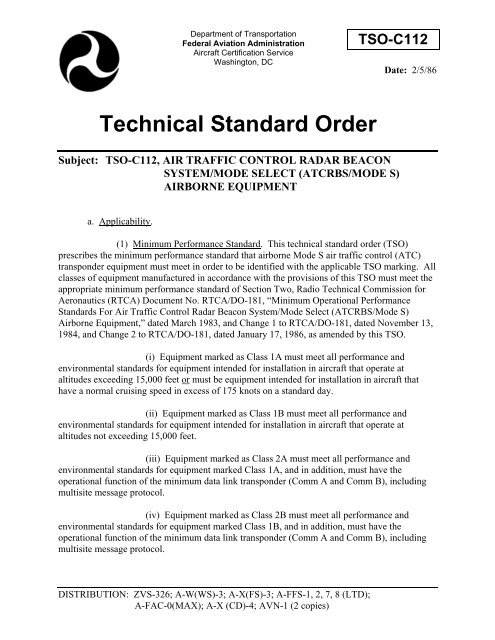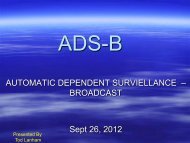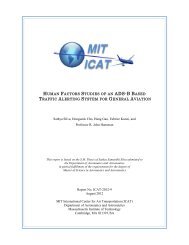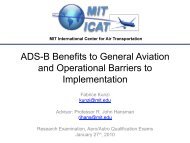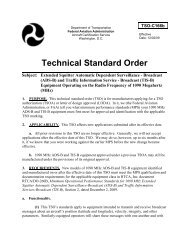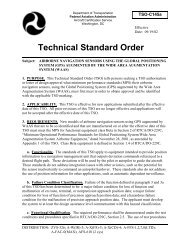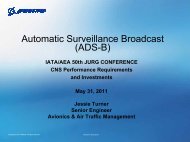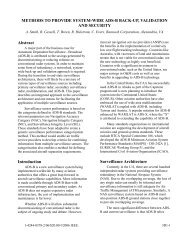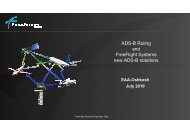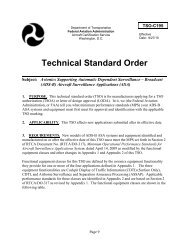TSO-C112 - ADS-B for General Aviation
TSO-C112 - ADS-B for General Aviation
TSO-C112 - ADS-B for General Aviation
Create successful ePaper yourself
Turn your PDF publications into a flip-book with our unique Google optimized e-Paper software.
Department of TransportationFederal <strong>Aviation</strong> AdministrationAircraft Certification ServiceWashington, DC<strong>TSO</strong>-<strong>C112</strong>Date: 2/5/86Technical Standard OrderSubject: <strong>TSO</strong>-<strong>C112</strong>, AIR TRAFFIC CONTROL RADAR BEACONSYSTEM/MODE SELECT (ATCRBS/MODE S)AIRBORNE EQUIPMENTa. Applicability.(1) Minimum Per<strong>for</strong>mance Standard. This technical standard order (<strong>TSO</strong>)prescribes the minimum per<strong>for</strong>mance standard that airborne Mode S air traffic control (ATC)transponder equipment must meet in order to be identified with the applicable <strong>TSO</strong> marking. Allclasses of equipment manufactured in accordance with the provisions of this <strong>TSO</strong> must meet theappropriate minimum per<strong>for</strong>mance standard of Section Two, Radio Technical Commission <strong>for</strong>Aeronautics (RTCA) Document No. RTCA/DO-181, “Minimum Operational Per<strong>for</strong>manceStandards For Air Traffic Control Radar Beacon System/Mode Select (ATCRBS/Mode S)Airborne Equipment,” dated March 1983, and Change 1 to RTCA/DO-181, dated November 13,1984, and Change 2 to RTCA/DO-181, dated January 17, 1986, as amended by this <strong>TSO</strong>.(i) Equipment marked as Class 1A must meet all per<strong>for</strong>mance andenvironmental standards <strong>for</strong> equipment intended <strong>for</strong> installation in aircraft that operate ataltitudes exceeding 15,000 feet or must be equipment intended <strong>for</strong> installation in aircraft thathave a normal cruising speed in excess of 175 knots on a standard day.(ii) Equipment marked as Class 1B must meet all per<strong>for</strong>mance andenvironmental standards <strong>for</strong> equipment intended <strong>for</strong> installation in aircraft that operate ataltitudes not exceeding 15,000 feet.(iii) Equipment marked as Class 2A must meet all per<strong>for</strong>mance andenvironmental standards <strong>for</strong> equipment marked Class 1A, and in addition, must have theoperational function of the minimum data link transponder (Comm A and Comm B), includingmultisite message protocol.(iv) Equipment marked as Class 2B must meet all per<strong>for</strong>mance andenvironmental standards <strong>for</strong> equipment marked Class 1B, and in addition, must have theoperational function of the minimum data link transponder (Comm A and Comm B), includingmultisite message protocol.DISTRIBUTION: ZVS-326; A-W(WS)-3; A-X(FS)-3; A-FFS-1, 2, 7, 8 (LTD);A-FAC-0(MAX); A-X (CD)-4; AVN-1 (2 copies)
<strong>TSO</strong>-<strong>C112</strong> 2/5/86(v) Equipment marked as Class 3A must meet all per<strong>for</strong>mance andenvironmental standards <strong>for</strong> equipment marked Class 2A, and in addition, must have theoperational function of the Uplink Extended Length Message (ELM) Capability (Comm C).(vi) Equipment marked as Class 3B must meet all per<strong>for</strong>mance andenvironmental standards <strong>for</strong> equipment marked Class 2B, and in addition, must have theoperational function of the Uplink Extended Length Message (ELM) Capability (Comm C).(vii) Equipment marked as Class 4 must meet all per<strong>for</strong>mance andenvironmental standards <strong>for</strong> equipment marked Class 3A, and in addition, must have theoperational function of the Full Extended Length Message (ELM) Capability (Comm D).(2) Options. The manufacturer may incorporate in Mode S transponderequipment one or more of the following options, as defined in RTCA/DO-181 (including Change1 and Change 2), and amended by this technical standard order.(i) Equipment marked as Class 1B or Class 2B may have a replytransmission frequency of 1090, ±1 Megahertz.(ii) Equipment marked as Class 1B or Class 2B may have a minimum RFPeak Output Power of 21.0 dBW (125 W).(iii) All classes of equipment may include diversity operations.(iv) Equipment marked as Class 2A, 3A, or 4 may have 25 foot altitudequantization, as defined in Change 1 to RTCA/DO-181.(v) Equipment marked as Class 2A, 2B, 3A, 3B, or 4, may include aircraftidentification, as defined in RTCA/DO-181 and Change 1 to RTCA/DO-181.(3) Software. The computer software package must be validated and verified in amanner acceptable to the Administrator. One acceptable means of compliance <strong>for</strong> validation andverification of the computer software package is outlined in RTCA/DO-178A, “SoftwareConsiderations in Airborne Systems and Equipment Certification,” dated March 1985. For thoseapplicants who elect to use RTCA document no. DO-178A to demonstrate compliance <strong>for</strong> theverification and validation of the computer software, the following requirements must be met:(i) RTCA document DO-178A defines three levels of software: Level 1,Level 2, and Level 3. The applicant must declare the level (or levels) to which the computersoftware has been verified ad validated. The equipment may incorporate more than one softwarelevel.(ii) The applicant must submit a software verification and validation plan<strong>for</strong> review and approval.Page 2
2/5/86 <strong>TSO</strong>-<strong>C112</strong>NOTE: The Federal <strong>Aviation</strong> Administration (FAA) strongly recommends early discussion andagreement between the applicant and the FAA on the applicant’s proposed software verificationand validation plan, and the applicant’s proposed software level or levels.(4) Environmental Standard. Change 2 to RTCA/DO-181 incorporates as areference RTCA document no. DO-160B, “Environmental Conditions and Test Procedures <strong>for</strong>Airborne Equipment,” dated July 1984.b. Marking. In addition to the marking specified in the Federal <strong>Aviation</strong> Regulations(FAR) Section 21.607(d), the following in<strong>for</strong>mation shall be legibly and permanently marked onthe major equipment components:(1) Each separate component of equipment that is manufactured under this <strong>TSO</strong>(antenna, receiver, transmitter, etc.) must be permanently and legibly marked with at least thename of the manufacturer and the <strong>TSO</strong> number.(2) With regard to FAR 21.607(d)(2), the part number is to include hardware andsoftware identification or a separate part number may be utilized <strong>for</strong> hardware and software.Either approach must include a means <strong>for</strong> showing modification status.(3) The equipment shall be identified by a designator. The marking shall use thegeneral <strong>for</strong>m as follows:CL 1x1 x2x3x4 x5x6x7Where “x i ” stands <strong>for</strong> an alphanumeric character describing the capability and the optionsincorporated in the transponder. The marking will be described here as three blocks of threecharacters each:First Block: CL 1 stands <strong>for</strong> the class of equipment and identifies this marking as theclassification label, coded1A = Class 1A, 1B = Class 1B, 2A = Class 2A,2B = Class 2B, 3A = Class 3A, 3B = Class 3B,04 = Class 4x 1 shall reflect the appropriate CA capability code that the transponder reports in itsAll-Call reply (reference RTCA/DO-181, paragraph 2.2.14.4.5)Second Block: x 2 : describes the RF power level of the reply transmitter, coded0 = low level, 1 = high levelx 3 : Aircraft Identification, codedPage 3
<strong>TSO</strong>-<strong>C112</strong> 2/5/860 = no AIS report, 1 = reports tail number only,2 = reports either tail number or flight plan numberx 4 : 25 foot altitude quantization, coded0 = 100 foot (standard) quantization1 = 25 foot and 100 foot quantization(100 foot above 50,175 ft.)Third Block: x 5 : Maximum Comm-D segment capability.Comm-D transponders are permitted to limit their burst capability to at least fourand at most 16 segments per reply sequence. This in<strong>for</strong>mation should beconsidered depending on the mission requirements of the transponder.The burst capability will be coded as a hexadecimal expression of value n-1,where n represents the maximum number of segments to be announced in a burst(the hexadecimal values would be 3 through E).x 6 : describes the reply transmission frequency, coded0 = 1090 ±3MHz, 1 = 1090 ±1MHzx 7 : Describes diversity operation, coded0 = No diversity capability, 1 = Diversity capabilityvalidated.(4) The level, or levels, to which the computer software has been verified andc. Data Requirements.(1) In addition to FAR § 21.605, the manufacturer must furnish the Manager,Aircraft Certification Office (ACO), Federal <strong>Aviation</strong> Administration (FAA), having purview ofthe manufacturer's facilities, one copy each of the following technical data:(i) Operating instructions.(ii) Equipment limitations.(iii) Installation procedures and limitations.(iv) Schematic drawings as applicable to the installation procedures.Page 4
2/5/86 <strong>TSO</strong>-<strong>C112</strong>(v) Wiring diagrams as applicable to the installation procedures.(vi) Specifications.(vii) List of the major components (by part number) that make up theequipment system complying with the standards prescribed in this <strong>TSO</strong>.document DO-160B.(viii) An environmental qualification <strong>for</strong>m as described in RTCA(ix) Manufacturer’s <strong>TSO</strong> qualification test report.(x) Nameplate drawing.(xi) The appropriate documentation as defined in RTCA/DO-178A orequivalent, necessary to support the verification and validation of the computer software toLevel 1, Level 2, or Level 3. If the software is verified and validated to more that one level, theappropriate documentation <strong>for</strong> all levels must be submitted.(2) In addition to those data requirements that are to be furnished directly to theFAA, each manufacturer must have available <strong>for</strong> review, by the Manager of the ACO havingpurview of the manufacturer’s facilities, the following technical data:(i) A drawing list, enumerating all of the drawings and processes that arenecessary to define the article design.(ii) The functional test specification to be used to test each productionarticle to ensure compliance with this <strong>TSO</strong>.(iii) Equipment calibration procedures.authorization).(iv) Corrective maintenance procedures (within 12 months after <strong>TSO</strong>(v) Schematic drawings.(vi) Wiring diagrams.(vii) Documentation to support the computer software verification andvalidation plan <strong>for</strong> Level 1, Level 2, or Level 3 software.(viii) The appropriate documentation as defined in RTCA/DO-178A orequivalent, necessary to support the verification and validation of the computer software toLevel 1, Level 2, or Level 3. If the software is verified and validated to more than one level, theappropriate documentation <strong>for</strong> all levels must be available <strong>for</strong> review.Page 5
<strong>TSO</strong>-<strong>C112</strong> 2/5/86d. Data to be furnished with manufactured units. One copy of the data and in<strong>for</strong>mationspecified in paragraphs (c)(1)(i) through (viii) of this <strong>TSO</strong> and instructions <strong>for</strong> periodicmaintenance and calibration which are necessary <strong>for</strong> continued airworthiness must go to eachperson receiving <strong>for</strong> use one or more articles manufactured under this <strong>TSO</strong>.e. Availability of Reference Documents.(1) Copies of RTCA document nos. DO-160B, DO-178A and DO-181 (includingChange 1 and Change 2) may be purchased from the Radio Technical Commission <strong>for</strong>Aeronautics Secretariat, One McPherson Square, 1425 K Street, NW., Suite 500, Washington,DC 20005.(2) Federal <strong>Aviation</strong> Regulations Part 21, Subpart O, and Advisory Circular20-110B, “Index of <strong>Aviation</strong> Technical Standard Orders,” may be reviewed at the FAAHeadquarters in the Office of Airworthiness, Aircraft Engineering Division (AWS-110), and atall regional ACO’s./S/ M. C. BeardDirector of AirworthinessPage 6


